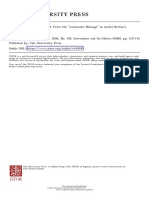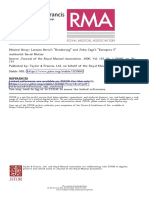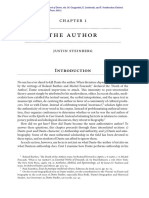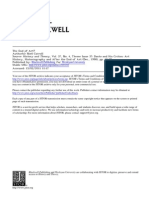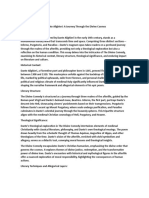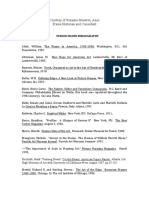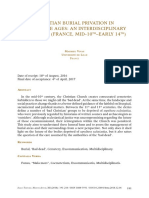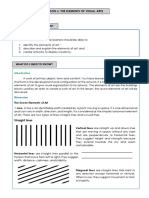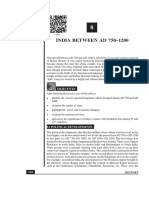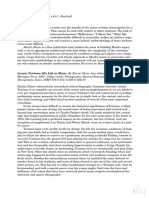Parker - Illuminating Botticelli's Chart of Hell 2013
Parker - Illuminating Botticelli's Chart of Hell 2013
Uploaded by
Germán Huici EscribanoCopyright:
Available Formats
Parker - Illuminating Botticelli's Chart of Hell 2013
Parker - Illuminating Botticelli's Chart of Hell 2013
Uploaded by
Germán Huici EscribanoCopyright
Available Formats
Share this document
Did you find this document useful?
Is this content inappropriate?
Copyright:
Available Formats
Parker - Illuminating Botticelli's Chart of Hell 2013
Parker - Illuminating Botticelli's Chart of Hell 2013
Uploaded by
Germán Huici EscribanoCopyright:
Available Formats
Illuminating Botticelli's Chart of Hell
Author(s): Deborah Parker
Source: MLN , January 2013, Vol. 128, No. 1, Italian Issue (January 2013), pp. 84-102
Published by: The Johns Hopkins University Press
Stable URL: https://www.jstor.org/stable/24463424
JSTOR is a not-for-profit service that helps scholars, researchers, and students discover, use, and build upon a wide
range of content in a trusted digital archive. We use information technology and tools to increase productivity and
facilitate new forms of scholarship. For more information about JSTOR, please contact support@jstor.org.
Your use of the JSTOR archive indicates your acceptance of the Terms & Conditions of Use, available at
https://about.jstor.org/terms
The Johns Hopkins University Press is collaborating with JSTOR to digitize, preserve and
extend access to MLN
This content downloaded from
139.47.18.255 on Wed, 15 Nov 2023 12:57:14 +00:00
All use subject to https://about.jstor.org/terms
Illuminating Botticelli's
Chart of Hell
Deborah Parker
Botticelli's Chart of Hell (c.1485-c.1500) has long been lauded as
one of the most compelling visual representations of Dante's Inferno.
The chart is one of ninety illustrations which the artist (1445-1510)
executed for a lavish codex of the Commedia commissioned by Lorenzo
di Pierfrancesco de' Medici, the cousin and ward of Lorenzo de'
Medici. Botticelli likely began work on the Dante illustrations in the
mid-1480s and finished them in the mid-1490s. Executed during a
period of considerable interest in infernal cartography, Botticelli's
Chart of Hell furnishes a panoptic display of the descent made by
Dante and Virgil through the "abysmal valley of pain" (/n/4.8).1
Notwithstanding the comprehensive nature of this representation of
the Inferno, it has been difficult for scholars to assess its full intricacy
due to the minute scale of the individual motifs. The original draw
ing measures 32.5 cm x 47.5 cm. The small figures in the original
measure less than one centimeter. Reproductions are often smaller,
compounding this difficulty. Most of the critical discussion has focused
on the artist's illustrations of the individual cantos. Kenneth Clark,
Peter Brieger, Millard Meiss, and Charles Singleton have clarified the
relationship of Botticelli's illustrations to earlier and later manuscript
I am indebted to Ricardo Padron, Tom Conley, and Ted Cachey for their comments
on an earlier version of this study that was delivered as a talk at the Renaissance Society
of America in 2009. I would like to thank Mark Parker, Paul Barolsky, Caroline Elam,
and Jonathan Nelson for their comments on an earlier draft of this essay.
'All citations from the Inferno are to the following edition: The Divine Comedy of Dante
Alighieri: Inferno, trans. Allen Mandelbaum (New York: Bantam, 1980, rpt. 2004).
MLN 128 (2013): 84-102 © 2013 by The Johns Hopkins University Press
This content downloaded from
139.47.18.255 on Wed, 15 Nov 2023 12:57:14 +00:00
All use subject to https://about.jstor.org/terms
MLN 85
Fig. 1. Botticelli, C
Vaticana.
illuminations representations of the Inferno.2 More recently, Peter
Dreyer, Barbara Watts and the contributors to the 2000-2001 exhibition
of Botticelli's illustrations to the Commedia have added considerably to
our understanding of the intricacies found in the illustrations to the
individual cantos. Less attention, however, has been paid to the ways
in which the map of Hell represents an ingenious interpolation of
the first canticle. One can read the map as one does the poem albeit
in a distinctly different way. This essay seeks to provide a different
perspective on the map, one that explores Botticelli's visual remedia
tion of a complex poetic narrative and how the artist literalizes that
which is allusive.3
-Kenneth Clark, The Draiuings of Sandro Botticelli for Dante's Divine Comedy: after the
originals in the Berlin Museums and the Vatican (New York: Harper Sc Row, 1976); Peter
H. Brieger, Millard Meiss, and Charles S. Singleton, Illuminated Manuscripts of the Divine
Comedy (Princeton: Princeton UP, 1969).
:5I employ remediation throughout this article along the terms discussed in Jay Bolter
and Richard Grusin, Remediation: Understanding New Media (Cambridge, MA: The MIT
Press, 1999). The two authors declare: "we call the representation of one medium in
another remediation, and we will argue that remediation is the defining characteristic
of new media" (45). Remediation transpires at different intensities and with different
attitudes toward the earlier medium. It can be reverential, simply re-presenting an
This content downloaded from
139.47.18.255 on Wed, 15 Nov 2023 12:57:14 +00:00
All use subject to https://about.jstor.org/terms
86 DEBORAH PARKER
My interest in the chart was itself
diation. I am the editor of The World
multimedia digital archive created
Divine Comedy. One of the compon
of the Chart of Hell. My collaborat
Technologies in the Humanities) c
from a large color transparency t
Vatican Library.4 As my colleague
representation of Botticelli's ma
of the artist's own act of remedia
poetic work in a visual medium. T
digitization proved especially propi
tantly, the version of the map on
to scrutinize and identify details s
easily and appreciate more fully th
a canny assimilation of Dante's na
demonstrate his extensive knowled
has been frequently observed—he
ing in the process an encapsulatio
the Chart of Hell the well-inform
in an alternative manner, savorin
intricate panoramic display.
In the Chart of Hell Botticelli spatia
a temporal experience, namely the
ticelli's movement from word to ima
the constraints and the serendipit
transactions. In what follows I will f
earlier medium, and in the process render
hostile, seeking to obliterate the predeces
Dante's poem is reverential. My interest li
changes the position of the viewer/reader.
4Ultimately we decided to furnish a more
World of Dante. We created two ways of vie
map on their own using Zoomify to enla
examine it through a transparent layer th
viewers the opportunity to select specific ci
are now labeled), follow the trajectory of D
of the two wayfarers. The colors in this v
in reproductions of the map and reflect t
Vatican Library. While a magnifying glass w
magnification through digitization, viewin
compartmentalize the image more. Zoomify
fied image. While the digital version allows u
that digital surrogates do not eliminate th
This content downloaded from
139.47.18.255 on Wed, 15 Nov 2023 12:57:14 +00:00
All use subject to https://about.jstor.org/terms
M LN 87
from the Infern
artist achieves t
finally how he p
not mentioned b
Recent studies
Giovanni Morello
tradition, to Ba
poem with a com
depictions such a
in Santa Maria N
the 1481 Landin
tions of Dante's I
as that of Botticelli. Nardo's fresco of 1354-57 renders Hell as a series
of stratified layers. The artist confines himself to representing the
punishments and some of the landscape of Hell. Rather than locating
the nine circles below one another, Nardo places the first five circles
of Hell adjacent to one another: the Lustful are depicted next to the
Gluttons, the Avaricious and Prodigal next to the Wrathful. Similarly,
all three rings of the seventh circle of the Violent are placed next to
one another. The focus is on the punishments: Dante and Virgil do
not appear anywhere in this rendition.5
Botticelli's Chart differs notably from Nardo's work, most notably
in the shape accorded Hell, the number of episodes depicted, and
the inclusion of the two wayfarers. The precision with which Botticelli
has rendered various stages of the voyage merits particular attention.
From Dante and Virgil's momentous passage through the Gate of Hell
to their dramatic exit, Botticelli illustrates more than fifty passages
from the poem. Many of the encounters with demons and souls are
portrayed. A comparison of the chart to the individual cantos reveals
a high degree of consistency suggesting that the chart was executed
after the illustrations had been completed. The only time the two
wayfarers are not shown on the Chart is in Malebolge, a section of
the map simply too small to allow the inclusion of their movements.
The artist's sources for the chart extend beyond sources adapted
from the miniatures of the manuscript tradition. Botticelli incorporates
details culled from Antonio du Tuccio Manetti's (1403-97) observa
Tor an example of a depiction of Dante's Inferno which does feature occasional
representations of the two travelers, typically in colloquy with one another, see the
reproduction of Bartolomeo di Fuorsino's illustration in Illuminated, Manuscripts of
the Divine Comedy, eds. Peter Brieger, Millard Meiss, and Charles S. Singleton, 2 vols.
(Princeton: Princeton UP, 1969) 2.31.
This content downloaded from
139.47.18.255 on Wed, 15 Nov 2023 12:57:14 +00:00
All use subject to https://about.jstor.org/terms
DEBORAH PARKER
Fig. 2. Nardo di Cione, Hell, 1354—7. Strozzi Chapel, Santa
Maria Novella, Florence.
tions concerning the Inferno's cartography in his rendition. Manetti's
ideas are posthumously outlined in Girolamo Benivieni's Dialogo di
Antonio Manetti (1506).6 Far more comprehensive than the synopsis
of Manetti's calculations published in Landino's 1481 commentary,
the Dialogo posits an extended conversation between Benivieni and
Manetti on the "site, form, and measurements of Hell." Basing his
6I am indebted to Ted Cachey for the reference to Manetti's role in the Benivieni
dialogue. For the text of the dialogue, which was published at the end of his 1506 Gi
untine edition of the poem, see Hieronymo Benivieni, Dialogo di Antonio Manetti,Cittadino
Fiorentino Circa al sito, forma et misure dello Inferno di Dante Alighieri, ed. Nicola Zingarelli
(Città di Castello: Lapi, 1807) 44-45, 65, 87, 104, 109. For discussions of the popularity
of discussions of Hell's topography in the late Quattrocento and early Cinquecento, see
John Kleiner, Mismapping the Underworld. Daring and Error in Dante's Comedy (Stanford,
CA: Stanford UP, 1994).
This content downloaded from
139.47.18.255 on Wed, 15 Nov 2023 12:57:14 +00:00
All use subject to https://about.jstor.org/terms
M LN 89
computations on
measures half t
rather than twe
Vè miles. On the Chart the circumference of the first five circles of
Hell is notably greater than the dimensions of Malebolge.
Botticelli also follows Manetti in his portrayal of other particulars.
Dante encounters the Neutrals or Pusillanimous souls in the vestibule
of Hell after passing through the Gate of Hell. In Benivieni's Dialogo
Manetti describes the place as "una grandissima cauerna tra la super
ficie dello aggregato et el fiume di Acheronte" ("an enormous cavern
between the surface of the aggregate and the Acheron River").7 Bot
ticelli follows Manetti both in installing the Neutrals in a cavern on
the Chart and portraying Upper Hell as an amphitheater. Manetti's
observations also likely inspired Botticelli's decision to depict the well
of the giants as rising perpendicular from Cocytus and the depiction
of Satan surrounded by a round sphere of ice. In his commentary
Landino does not comment on these particulars.8 Taken together
these details show that Botticelli had not only assimilated earlier
manuscript illustrations and the particulars of Dante's text, but also
contemporary critical observations about Hell's cartography.9 In this
respect the Chart of Hell furnishes a particularly Florentine interpre
tation of Hell's topography.
Such obsessive detail was not always appreciated. Vasari chides Bot
ticelli for having "wasted much of his time, bringing infinite disorder
to his life" in devoting so much time to studying Dante, but such
assiduous attention is not without considerable merit.10 The Chart
'Benivieni, Dialogo 104.
8For Landino's synopsis of Manetti's mathematical calculations on the dimensions
and form of the Inferno, see Cristoforo Landino, Comento sopra la Comedia, ed. Paolo
Procaccioli, 4 vols. (Rome: Salerno, 2001)1.270-78. Landino makes no mention of any
cavern in his discussion of the Neutrals nor does he comment on shape of the well of
the giants. In his illustration to Inf.34 Botticelli draws a circle around the middle of
Satan's body that is clearly intended to represent the lake of ice that surrounds him
and which is visible on the Chart.
9It is possible that Botticelli learned of Manetti's ideas from personal acquaintance.
Herbert Home discovered in a ricordo of Manetti, he copied a letter of Simone di
Mariano Botticelli, the artist's brother. See Herbert P Home, Botticelli Painter of Florence
(London, 1908, reprinted Princeton: Princeton UP, 1980) 271. Given that he illustrated
Landino's 1481 Dante, he would have been familiar with Landino's synopsis of Manetti's
calculations on the dimensions of the Inferno.
'"Giorgio Vasari, "Sandro Botticelli," Lives of the Painters, Sculptors and Architects, trans.
Gaston du C. de Vere, 2 vols. (New York: Alfred A. Knopf, 1996)1:538. For the Italian
text, Giorgio Vasari, Le vite dei più eccellenti pittori, scultori e architetti, ed. Paola Delia
Pergola, Luigi Grassi and Giovanni Previtali (Novara Istituto Geografico de Agostini
Rome: Newton Compton, (1996 ) 3.198-99 in which Vasari notes "e figuré lo inferno e
lo mise in stampa, dietro al quale consumé di molto tempo, per il che non lavorando
fu cagione di infiniti disordini alia vita sua."
This content downloaded from
139.47.18.255 on Wed, 15 Nov 2023 12:57:14 +00:00
All use subject to https://about.jstor.org/terms
90 DEBORAH PARKER
of Hell attests to an astonishing f
1 shows my estimation of the pa
Chart. Beginning with the openin
inscription over Hell's gate, Botti
and Virgil's encounters with the
among the Virtuous Pagans, the L
and the Wrathful. Among the latter
Dante and Virgil to the gates of Dis,
Lower Hell, and their entry into
painter illustrates all three rings
the bloody waterfall which runs
the Usurers; Geryon flying Dante
the punishments of the fraudule
Malebolge; the Giants, including
Dante and Virgil down to Cocytu
replete with a detail of Alessandr
instance of fratricide among the
and Virgil climbing down Satan's
himself to depicting the major div
in Renaissance or modern maps
depict all the punishments descri
successive meetings with sinners o
Such moments are especially appa
first five circles of Hell. This remarkable attention to detail is extended
to the depiction of Hell's topography and architecture. We see, for
example, the seven walls surrounding the castle of Limbo. The Chart
even shows vestiges of the earthquake caused by the Harrowing of Hell:
the artist has meticulously depicted the mass of tumbled rocks outside
the tomb of Anastasius II and the broken ridge over the bolgia of the
Hypocrites in Malebolge. The precision extends to Malebolge itself
where we can see minutely rendered particulars such as the crucifixion
of the arch-hypocrite Caiaphas, a reptilian monster attacking the thief
Vanni Fucci, and a decapitated Bertran de Born, the Provençal poet
who sowed discord between Henry I and his son.
The inclusion of such details shows not only the comprehensive
nature of this pictorial adaptation of Hell, it attests to Botticelli's skill
as a draughtsman. The Dante drawings were initially incised with a
blind stylus into the parchment, and then overdrawn with a lead-tin
stylus that leaves a grey line. The artist subsequently went over these
drawings with brown iron-gall ink before painting in the colors with
the kind of tempera pigments used by manuscript illuminators. The
gilded border constitutes one of the most striking features of the Chart
of Hell: it creates an illusionistic effect, producing essentially the look
This content downloaded from
139.47.18.255 on Wed, 15 Nov 2023 12:57:14 +00:00
All use subject to https://about.jstor.org/terms
M LN 91
of a gilded frame
of the Dante illu
the painstaking
One of the most distinctive features of the Chart of Hell is Botti
celli's insistent focus on the progress of Dante and Virgil through the
abyss: the two wayfarers appear no less than twenty-seven times. As in
the detailed illustrations to the cantos, Dante is attired in a scholar's
cap and sleeveless lucco, a loose-fitting tunic worn by persons of dif
ferent ranks over a green long-sleeved cassock; Virgil wears a blue
long-sleeved undergarment, a purple sleeveless over garment and
a taller cone-shaped hat. Whereas some earlier manuscripts tend to
show him garbed in blue, in the chart Dante wears red, possibly fol
lowing a Florentine tradition. From the portrait of the poet attributed
to the school of Giotto in the Bargello's Capella della Maddalena
to Domenico di Michelino's Dante Reading from the Divine Comedy in
Florence's Duomo, Dante is consistently shown in a red garment.13
Without the multiple portrayals of the two wayfarers, we would be
left with a static cross-section of Hell. In portraying the trajectory of
their descent, however, Botticelli creates two unique perspectives: if
we examine the map from top to bottom, we can follow the progres
sion of Dante's and Virgil's journey, which in turn follows Dante's
narrative. If, on the other hand, we look at the map all at once we
have the impression of viewing the entire journey simultaneously.
Botticelli effectively transforms the linear experience of reading the
poem into a panoptic display.
Botticelli's pictorial narrative differs from the poetic one in an
important way: there is no distinction between Dante the poet and
Dante the pilgrim. On the Chart of Hell Dante is objectified, form
ing an indivisible unit with his guide Virgil. Indeed one might easily
conclude that Virgil is the more prominent figure: if one looks closely
at each of the depictions, we see that Dante is almost always behind
Virgil, who is often pointing out something to his charge. In portray
"I arn indebted to Caroline Elam for the information on Botticelli's technique of
illustration and the depiction of the illusionistic gilded border.
12On this point see Charles Dempsey, "Botticelli, Sandro," Encyclopedia of Italian
Renaissance and Mannerist Art, ed. Jane Turner, 2 vols. (London: Macmillan Reference
Limited, 2000) 1.246. For a detailed discussion of the artist's drawing techniques in
the Dante illustrations, see Doris Oltrogge, Robert Fuchs, and Olivia Hahn, "Finita and
Non finito Techniques in Botticelli's Divine Comedy, in Sandro Botticelli," The Drawings for
Dante's Divine Comedy (London: Royal Academy of Arts, 2000): 334-41.
I5For an excellent overview of Renaissance portraits of Dante, see Jonathan Nelson,
"Dante Portraits in Sixteenth-Century Florence," Gazette des Beaux-Arts (1992):59—77.
This content downloaded from
139.47.18.255 on Wed, 15 Nov 2023 12:57:14 +00:00
All use subject to https://about.jstor.org/terms
92 DEBORAH PARKER
ing the two travelers together, the
the poet who narrates the story o
experiences it. The map begins w
the Gate of Hell. Interestingly, B
dark night of the soul in the dark
cantos. This decision further occlu
In this encyclopedic rendering, t
those of the poet, are subsumed t
the grand design of Hell.
Botticelli's objective, however, w
pilgrim distinction. The artist see
rative in his numerous depictions
have noted the artist's interest in
story, a convention derived from fo
in the Moses frescoes in the Sisti
Life and Miracles of St. Zenobius, an
the Story of Virginia, the Story of
Nastagio degli Onesti. The Moses
before Botticelli undertook the D
and Lucretia paintings, executed in
of a narrative both within a single
We can best appreciate the way i
tive progression by examining his
In his rendition of Limbo, Botticelli illustrates four of the incidents
recounted in Inf.4: we see Virgil, Lucan, Homer, Ovid and Horace
standing before a fire, pausing at the entrance to the castle, travers
ing a green meadow within the castle's walls, and paying tribute to
Dante. As Dante reports, the "bella scola" ("splendid school") of
pagan poets claim him as one of their own, declaring him "sesto fra
cotanto senno," ("sixth among such intellects"; /w/4.102), a detail
which Botticelli artfully heightens by elevating Dante above the other
five poets—exaggerating in so doing Dante's claim of equality. Bot
ticelli also portrays multiple episodes recounted in the meeting with
the Lustful: we see Dante and Virgil before Minos, their observation
that the "bufera infernal" ("hellish hurricane"; Inf.5.31) that batters
the Lustful, Dante speaking to Paolo and Francesca, and finally the
pilgrim's swoon upon hearing her doleful tale. Botticelli's treatment
of Geryon also shows his interest in portraying the progressive stages
14For an excellent discussion of the way in which Botticelli portrays narrative in the
Nastagio degli Onesti panels, see Christina Olsen, "Gross Expenditure: Botticelli's
Nastagio degli Onesti Panels," Art History 15 (1992): 146-70.
This content downloaded from
139.47.18.255 on Wed, 15 Nov 2023 12:57:14 +00:00
All use subject to https://about.jstor.org/terms
M LN 93
Fig. 3. Botticelli, De
of the journey:
at the top of th
Since Botticelli's
possible to com
Chart to his tre
ment of Geryo
shows shows th
of narration, w
In both the Chart of Hell and the illustrations for the individual canti,
Botticelli takes pains to render successive events, essentially spatial
izing the temporal experience of reading Dante's narrative. Rather
than reading down the page of the manuscript, the viewer "reads" the
trajectory of the voyage as Botticelli portrays it.
What I have called the spatialization of poetry is most evident in
details that Botticelli adds to the Chart. Botticelli takes into account
what is not explicitly recorded by Dante but can be inferred from th
poem. His depiction of the scene at the river Acheron exemplifies
this tendency. Whereas Dante describes the misery of the recently
arrived damned souls and compares their descent into Charon's
boat to falling leaves (itself a Virgilian simile), Botticelli shows what
happens after the damned tumble into Charon's boat, namely their
transport across the Acheron. Botticelli's portrayal of Charon, on th
other hand, illuminates another canny interpretation of what Dante'
This content downloaded from
139.47.18.255 on Wed, 15 Nov 2023 12:57:14 +00:00
All use subject to https://about.jstor.org/terms
94 DEBORAH PARKER
fti
Fig. 4. Botticelli, Detail of Geryon, Chart of Hell, World of Dante.
T'
hM
IMm
: .V - - ....
Fig. 5. Botticelli, Detail of I
Dante's Divine Comedy, Kup
This content downloaded from
139.47.18.255 on Wed, 15 Nov 2023 12:57:14 +00:00
All use subject to https://about.jstor.org/terms
MLN 95
words suggest.
occhi di braga
109). While Da
no mention of
hoary cheeks (
is economical,
ferryman as a
cal appearance
depictions of C
Cortese also de
first half of th
imaginative inte
wings, Cortese
guardians who
that populate D
the patterns ex
Other interpre
For example,
castello" toward which Dante walks with the luminaries of the "bella
scola." Botticelli embellishes the allusion to the seven walls that sur
round the castle by adding seven towers. Possibly a symbol of the seven
liberal arts, the addition of seven towers underscores the distinctive
nature of the castle and its inhabitants within the landscape of Limbo.
Earlier manuscript illustrations usually show only one tower. Although
Dante does not describe the landscape of Limbo aside from the area
around the castle, Botticelli creates his own topography, portraying the
area outside the castle as a barren landscape and in so doing makes
the landscape of the first circle consistent with that of the rest of the
Inferno. As in his portrayal of Charon, the artist furnishes details not
provided by the poet. Where Dante condenses, Botticelli here expands.
At once we sense how fortunate these noble souls are, as we grasp
their splendid isolation amid a landscape of death, despair, and suf
fering. Botticelli's treatment provides an emphatic contextualization
for the Virtuous Pagans—the afterlife as a limited respite from pain,
not the full glory of Paradise.
We find another canny inference in the artist's depiction of the Usu
rers. While the Usurers are punished in the burning plain along with
15See Illuminated Manuscripts 2.64.
16It is worth noting that the illustration attributed to Giuliano di Sangallo by Dreyer
also shows Charon with wings. Hence Botticelli and the artist of this drawing are likely
following earlier depictions of Charon with wings in illuminated manuscripts. This draw
ing also includes one set of stairs and shows Satan surrounded by a circular lake of ice.
This content downloaded from
139.47.18.255 on Wed, 15 Nov 2023 12:57:14 +00:00
All use subject to https://about.jstor.org/terms
96 DEBORAH PARKER
Fig. 6. Botticelli, Detail of Charon, Chart of
the Sodomites and Blasphemers, D
them until the middle of Inf. 17, in
the misery of the Usurers between
flight to the eighth circle. In his
that the Usurers are "su l'orlo al
the seventh circle").17 Botticelli, h
a distinct and. subtle way: he plac
and Blasphemers (see fig.4). Their
tion of the Usurers from the othe
follows the same procedure in his
precipice drops off even more sha
Usurers sitting on the ledge belo
In both the Chart and the illustr
objectification of the poem enforces
subjective narrative need not foll
One of Botticelli's most notable v
of stairways between the vestibu
circles (Gluttons and the Avarici
fourth and fifth circles (Avarici
(see fig.4). At no point in the Infe
wayfarers descend from one circl
17Landino 2.724.
18Other manuscript illustrators tend to show the usurers on the same plane as Dante
and Virgil. See Illuminated Manuscripts 2.197.
This content downloaded from
139.47.18.255 on Wed, 15 Nov 2023 12:57:14 +00:00
All use subject to https://about.jstor.org/terms
M LN 97
of the Phlegeth
lier, Virgil desc
'1 loco è tondo;
calando al fond
the way you ha
the bottom"; /w
back, Virgil dec
is by this kind
metaphorically
Satan's body as
Hell (Inf.34.82).
not symbolic b
and Virgil make
constitute a disti
simply what th
Such features of
the script put fo
ticularly visual
ing the means b
circle to anothe
through Hell in
which is allusiv
providing detail
We might ask ou
reading Dante'
does the eye m
prominence in
First of all the
position of the
process with a
of viewing the
Although one m
tom, the minuteness of the details makes this difficult. The viewer's
eye tends to move between individual detail and the overall structure
of Hell. What we might call the work of reading—the recollection
19Watts 176. In another article Watts notes that Botticelli renders Dante's geography
more exact in Purgatory. For example, the artist portrays Dante's and Virgil's progress
through "quella cruna" ("needle's eye") of Purg. 10.16, a narrow opening in the rock
of mountain of Purgatory by showing the poets' progress through a narrow opening
of stone. See Barbara J. Watts, "Artistic Competition, Hubris, and Humility: Sandro
Botticelli's Response to Visibile Parlare," Dante Studies 114 (1996):44.
This content downloaded from
139.47.18.255 on Wed, 15 Nov 2023 12:57:14 +00:00
All use subject to https://about.jstor.org/terms
98 DEBORAH PARKER
of past events and the anticipatio
manifest and inescapable. In this
a visual index or synopsis to whic
the Inferno. What Dante's reader,
forget in the immediacy of the m
really evade in this visual synopsi
of focus, every place in Hell is alw
with a demon or soul is seen in terms of the overall structure of Hell.
As a result, momentous encounters such as Dante's meetings with
Paolo and Francesca, Farinata, Pier della Vigna, or Ugolino become
small details in the larger representation of damnation. Propinquity
and intimacy give way to panoptic display; detail is subordinated to
structure; human emotions are subsumed to the divine design of Hell.
These details, in turn, are given their due in the detailed drawings
to the cantos.
It is worth noting that Dante provides his own "chart of Hell" in Inf.
11. As the two wayfarers accustom themselves to the stench of Lower
Hell, Virgil takes the opportunity to explain the division of sins in the
Inferno by describing the sins of violence and fraud whose inhabitants
are punished in the seventh and eighth circles:
"My son, within this ring of broken rocks,"
he then began, "there are three smaller circles;
like those that you are leaving, they range down.
Those circles are all full of cursed spirits;
so that your seeing of them may suffice,
learn the how and why of their confinement.
Of every malice that earns hate in Heaven,
Injustice is the end; and each such end
by force or fraud brings harm to other men.
However, fraud is man's peculiar vice;
God finds it more displeasing—and therefore,
The fraudulent are lower, suffering more.
The violent take all of the first circle;
but since one uses force against three persons,
that circle's built of three divided rings.
To God and to one's self and to one's neighbor—
I mean, to them or what is theirs—one can
Do violence, as you shall now hear clearly [...]" {Infill. 16-33)
Explicating prosaically matters such as the three main categories of sin
(incontinence, violence and fraud), what transgressions are punished
in each division, and the difference between fraud and treachery, Dante
renders into poetry Aristotelian ideas on malice and the dispositions
This content downloaded from
139.47.18.255 on Wed, 15 Nov 2023 12:57:14 +00:00
All use subject to https://about.jstor.org/terms
MLN 99
of the soul tha
won little prais
a "filler" by cri
lander puts it:
gone before (a
ing but pedant
moment in wh
such, this account of the overall scheme of Hell furnishes a reveal
ing point of comparison with Botticelli's panoptic display, ultimately
affording an opportunity to examine the way in which the artist's
visual embodiment of the narrative affects fruition. In a sense the
viewer of the Chart of Hell is in the same position as the reader of
Inf. 11: whether studying the chart or reading this canto, the overall
structure of the "blind prison" is always apparent.
Botticelli's remediation of the poem, his representation of the
entire journey in all its simultaneity, changes the subject position of
the reader/viewer significantly. To see this difference one need only
compare the experience of reading of Inf. 10 to Inf.W. The pilgrim's
highly dramatic encounter with Farinata throws us inside the volatile
world of Florentine politics. Dante is initially daunted as he stands
before Farinata, who rises imperiously from his sepulcher, "com'avesse
l'inferno a gran dispitto" ("as if he had tremendous scorn of Hell";
/w/10.36). It is not Farinata's place in the larger scheme of punish
ment and damnation that is foremost here; it is the tension between
him and Dante, which arises both from personal relations and political
commitment that animates this scene. In listening to Virgil's explana
tion of the divisions of Hell and disposition of its inhabitants in Inf.W,
however, individuality is subordinated. It is as if we are looking at ants
from a great height: we see the mass not the individual.
Whereas Dante's textualized account of space in Inf. 11 has its
longuers, Botticelli's readable map is marvelously engaging. While
the intricacy of the map would impress any viewer, the painstaking
rendering of so many moments from the Infernal voyage offers some
thing akin to a zvunderkammer for readers with a profound knowledge
of the first canticle. Ultimately, viewing the Chart of Hell becomes
an act of memory, as its wondrous particulars take the reader/viewer
back to the original through artful remediation. Botticelli's visual
embodiment of the Inferno is not transparent. The artist intervenes
20Dante Alighieri, Inferno, trans. Robert and Jean Hollander (New York: Doubleday,
2000)194.
This content downloaded from
139.47.18.255 on Wed, 15 Nov 2023 12:57:14 +00:00
All use subject to https://about.jstor.org/terms
100 DEBORAH PARKER
in his remediation to put his own s
Dante's role in it. If reading the po
the Chart of Hell shifts our mode of
to outside. The artist has brilliantly
poem but Florentine culture in ada
of Hell's topography. The Chart effec
to the public sphere, from a subject
Dante's vision to a cultural view of
What we see, then, in this compa
between word and image, is a parti
Dante's commitments to the tempor
sive experience of reading produc
immediacy of appeal. We are most
ticelli's representation foreground
the effect of flattening encounters w
us the context for each sin. The po
to the chart's timeless qualities of s
illusionistic sculptures in Purgatory
verisimilitude of great art, memora
(Purg. 10.95) Botticelli has furnish
image—"legibile dipingere"—somet
from an artist whom Vasari aptly d
University of Virginia
APPENDIX 1
Passages from the Inferno Depicted on Botticelli's Chart of Hell
Inf.3.1-9: Dante and Virgil read inscription over the Gate of He
Inf.3.55-57: Neutrals chasing a banner
Infi.70-72: Damned before Charon's boat
Inf.3.78: Acheron
/n/3.82: Charon
21Vasari, Le vite dé più eccellenti pittori 3.198. For an intriguing discussion of
Botticelli's illustrations to Purg. 10, which are strikingly illusionistic in their use o
spective to portray a three dimensional sense of space, might constitute a respon
Dante's claim that human art cannot hope to match the realism of God's art, see W
"Artistic Competition." See also Barbara Watts, "The Word Imaged: Dante's Comm
and Sandro Botticelli's San Barnaba Altarpiece," Lectura Dantis. Visibile Parlare.
and the Art of the Italian Renaissance, ed. Deborah Parker (1998):203-46.
This content downloaded from
139.47.18.255 on Wed, 15 Nov 2023 12:57:14 +00:00
All use subject to https://about.jstor.org/terms
MLN 101
Inf 4.68: Dante a
Horace
Inf.4.106: The six poets at entrance of the castle
Inf A. Ill: The six poets converse on a meadow inside the castle
Inf.5A: Dante and Virgil before Minos
Infb. 31-33: Punishment of the Lustful
Inf.5.74: Dante and Virgil speaking to Paolo and Francesca
Inf.5.142: Dante's swoon
Inf.6.13-15: Dante and Virgil before Cerberus
7n/6.19-21: Punishment of the Gluttons
Inf.6.38: Dante and Virgil speaking to Ciacco
Inf.7.4: Dante and Virgil before Plutus
Inf.7.25-27: Punishment of the Avaricious and Prodigal
\nf.7.100-03: Descent to Styx
/n/7.112-20: Punishment of the Wrathful and Sullen
Inf.8.16-17: Phlegyas in his boat
Inf.8.76-81: Phlegyas leaves Dante and Virgil at the Gates of Dis
Inf.9.121-23: Punishment of the Heretics
Inf. 11.2: Mass of toppled rock caused by Harrowing of Hell
Inf. 11.7-9: Tomb of Anastasius II
/n/12.47: Phlegethon
Inf. 12.52-57: Punishment of the Murderers, Plunderers, and Tyran
7n/.l 3.4—6: Wood of the Suicides
Inf.14. 19-24: Punishment of the Blasphemers and Sodomites
Inf.18.103-05: Bloody waterfall
Infi 7.31-36: Punishment of the Usurers
Inf. 17.115-17: Geryon flying Dante and Virgil to the top of the eighth Circl
Infi7.43-44: Dante observes the Usurers
Inf. 18.1-21: Dante and Virgil survey Malebolge
Inf.18.34-36: Punishment of the Panderers and Seducers
Inf.18.112-14: Punishment of the Flatterers
InjT9.22-24: Punishment of the Simonists
Inf.28.10-15: Punishment of the Diviners
Inf.21.19-21: Punishment of the Barrators
Inf.21.106-08: Broken bridge over the sixth bolgia (Hypocrites)
Inf.23.58-63: Punishment of the Hypocrites
Inf.28.115-23: Punishment of arch-hypocrites (Caiaphas and other
Pharisees)
Inf.24.91-96: Punishment of the thieves, including Vanni Fucci (show
seated on the left attacked by snakes)
Inf.28.40-41: Punishment of the False Counselors
This content downloaded from
139.47.18.255 on Wed, 15 Nov 2023 12:57:14 +00:00
All use subject to https://about.jstor.org/terms
102 DEBORAH PARKER
Inf.28.38-42: Punishment of the Sow
Inf.29.46-51: 67-69: Punishment of
Infix.31-33: Giants
Inf.iX.70-78: Nimrod with his horn
Infi] .115-29: Virgil addressing Ant
Inf.iX. 142-43: Antaeus lowering Da
Inf.i2.22-23: Cocytus
InfiA. 11-15: Punishment of the tra
Alessandro and Napoleone degli Alb
InfiA.53-57: Satan gnawing on Jud
This content downloaded from
139.47.18.255 on Wed, 15 Nov 2023 12:57:14 +00:00
All use subject to https://about.jstor.org/terms
You might also like
- Hodges - The Guild Handbook of Scientific IllustrationDocument612 pagesHodges - The Guild Handbook of Scientific IllustrationGermán Huici Escribano100% (2)
- Fabrizio. Michelangelop and MusicDocument7 pagesFabrizio. Michelangelop and MusicPriscila MatsunagaNo ratings yet
- Lynne Kirby - Painting and CinemaDocument11 pagesLynne Kirby - Painting and Cinemaj a50% (2)
- Luchino ViscontiDocument221 pagesLuchino Viscontia.kadmel5280No ratings yet
- Love Story ViolinDocument1 pageLove Story ViolinDaniviolin67% (3)
- Armstrong Ceilings and Walls Specifiers ReferenceDocument586 pagesArmstrong Ceilings and Walls Specifiers Referencemantencion CRINo ratings yet
- Botticelli ChartDocument20 pagesBotticelli ChartAnistro_A50% (2)
- College Art AssociationDocument19 pagesCollege Art AssociationJuan GonzálezNo ratings yet
- Marmor - From Purgatory To Primavera Observations-2003Document15 pagesMarmor - From Purgatory To Primavera Observations-2003Germán Huici EscribanoNo ratings yet
- Dante, Chaucer, and The Poetics of The PastDocument362 pagesDante, Chaucer, and The Poetics of The Pastايمن عبد التوابNo ratings yet
- KETTERER, Robert C. - Militat Omnis Amans. Ovidian Elegy in L'Incoronazione Di PoppeaDocument16 pagesKETTERER, Robert C. - Militat Omnis Amans. Ovidian Elegy in L'Incoronazione Di PoppeaRamiroGorritiNo ratings yet
- This Content Downloaded From 2.84.16.202 On Fri, 18 Mar 2022 10:02:04 UTCDocument16 pagesThis Content Downloaded From 2.84.16.202 On Fri, 18 Mar 2022 10:02:04 UTCrafaela sampaio agapito fernandesNo ratings yet
- Truth, Autobiography.Document23 pagesTruth, Autobiography.MarionetteNo ratings yet
- Gombrich - BotticelliDocument63 pagesGombrich - BotticelliTalita Lopes100% (1)
- This Content Downloaded From 82.49.44.75 On Thu, 04 Feb 2021 20:45:53 UTCDocument23 pagesThis Content Downloaded From 82.49.44.75 On Thu, 04 Feb 2021 20:45:53 UTCPatrizia MandolinoNo ratings yet
- Art History-Botticelli PDFDocument5 pagesArt History-Botticelli PDFNevenaNo ratings yet
- Imagining The Elements With Gaston Bachelard and Claire Denis: 'Weighted' Images, Drift and Diffusion in L'Intrus/The IntruderDocument20 pagesImagining The Elements With Gaston Bachelard and Claire Denis: 'Weighted' Images, Drift and Diffusion in L'Intrus/The IntruderSaige WaltonNo ratings yet
- About Death in Jean CocteauDocument178 pagesAbout Death in Jean CocteauLauraValeria100% (1)
- Desiderio and Diletto Vision Touch and TDocument23 pagesDesiderio and Diletto Vision Touch and TJavier Martinez EspuñaNo ratings yet
- ART1013 Early Renaissance in Italy AssignmentDocument19 pagesART1013 Early Renaissance in Italy Assignmenthannah.dandria.23No ratings yet
- Art History and The Invention of BotticelliDocument203 pagesArt History and The Invention of BotticelliYnnodusNo ratings yet
- Dante ExileDocument25 pagesDante Exilefeyza düşgünNo ratings yet
- Making Sense of The Absurd - A Comparative Study of The Works of David Lynch and Luigi PirandelloDocument32 pagesMaking Sense of The Absurd - A Comparative Study of The Works of David Lynch and Luigi PirandelloCynthia VandenbruaeneNo ratings yet
- Danto, A. (1989) - Narratives of The End of Art. Grand Street, Vol. 8, No. 3. Pp. 166-181Document17 pagesDanto, A. (1989) - Narratives of The End of Art. Grand Street, Vol. 8, No. 3. Pp. 166-181ricardo30561No ratings yet
- Mix FictionDocument87 pagesMix FictionCrisNo ratings yet
- Steinberg - The Oxford Handbook of Dante 2021Document14 pagesSteinberg - The Oxford Handbook of Dante 2021sevdeNo ratings yet
- 5 - Baxandall PDFDocument13 pages5 - Baxandall PDFFátima JussaraNo ratings yet
- Titian's Fire by Paul HillsDocument20 pagesTitian's Fire by Paul Hillsarp_mNo ratings yet
- Metaphysical Conceit in Baroque PoetryDocument16 pagesMetaphysical Conceit in Baroque PoetryleszkeryNo ratings yet
- ParadiseDocument35 pagesParadisemachtokNo ratings yet
- Because I Could Not Stop For Death' and The Birth of Venus' AnalysisDocument5 pagesBecause I Could Not Stop For Death' and The Birth of Venus' Analysishillary ochiengNo ratings yet
- Bette Talvacchia Bronzinos Del Pennello and The Pleasures of Art MainDocument18 pagesBette Talvacchia Bronzinos Del Pennello and The Pleasures of Art MainYnnodusNo ratings yet
- Frederick Antal - Some Examples of The Role of The Mænad in Florentine Art of The Later Fifteenth and Early Sixteenth Centuries PDFDocument6 pagesFrederick Antal - Some Examples of The Role of The Mænad in Florentine Art of The Later Fifteenth and Early Sixteenth Centuries PDFMiguel Ángel Rego RoblesNo ratings yet
- American Association of Teachers of French The French ReviewDocument6 pagesAmerican Association of Teachers of French The French ReviewaijmaisNo ratings yet
- PurgatoryDocument35 pagesPurgatorymachtokNo ratings yet
- Arti Poveri, Michael ColeDocument23 pagesArti Poveri, Michael ColeRenato MenezesNo ratings yet
- J. B. Trapp. Petrarchs Laura. The Portraiture of An Imaginary BelovedDocument139 pagesJ. B. Trapp. Petrarchs Laura. The Portraiture of An Imaginary BelovedALALALNo ratings yet
- Who's Pulling The StringsDocument7 pagesWho's Pulling The StringstomerhodNo ratings yet
- BalijaDocument19 pagesBalijaNatasha BillaNo ratings yet
- Dantes Inferno PresentationDocument19 pagesDantes Inferno Presentationapi-695454720No ratings yet
- Eliot's Purgatorio - The Structure of Ash WednesdayDocument17 pagesEliot's Purgatorio - The Structure of Ash WednesdayMila BoschiNo ratings yet
- Art, Society, and The Bouguer PrincipleDocument13 pagesArt, Society, and The Bouguer PrincipleOmega ZeroNo ratings yet
- Thumiger - 2009 - On Ancient and Modern (Meta) Theatres Definitions and PracticesDocument51 pagesThumiger - 2009 - On Ancient and Modern (Meta) Theatres Definitions and Practicesliucangcang1130No ratings yet
- The End of ArtDocument14 pagesThe End of ArtvuvuzelicaNo ratings yet
- Conradie, Johan - Odd NerdrumDocument83 pagesConradie, Johan - Odd NerdrumMauricio de AssisNo ratings yet
- Bott002 PDFDocument11 pagesBott002 PDFTalita LopesNo ratings yet
- The Lies of the Artists: Essays on Italian Art, 1450-1750From EverandThe Lies of the Artists: Essays on Italian Art, 1450-1750No ratings yet
- Joseph Geiger - Giambettino Cignaroli's Deaths of Cato and of SocratesDocument10 pagesJoseph Geiger - Giambettino Cignaroli's Deaths of Cato and of SocratesM MNo ratings yet
- Boccaccio, Cavalcanti's Canzone "Donna Me Prega" and Dino's GlossesDocument19 pagesBoccaccio, Cavalcanti's Canzone "Donna Me Prega" and Dino's GlosseskdalinkNo ratings yet
- Blanchot Death of VirgilDocument16 pagesBlanchot Death of VirgilfrederickNo ratings yet
- Mozart - Čarobna Frula Kao Masonska OperaDocument28 pagesMozart - Čarobna Frula Kao Masonska OperaRadoslavNo ratings yet
- Dante Poet of The Secular WorldDocument5 pagesDante Poet of The Secular WorldLucas MouraNo ratings yet
- Debussy's Concept of The DreamDocument14 pagesDebussy's Concept of The Dreammario100% (1)
- Book Review Dante - Divine ComedyDocument5 pagesBook Review Dante - Divine ComedyDorottya MészárosNo ratings yet
- 7Document2 pages7japonpuntocomNo ratings yet
- Comedy - Tragedy - and - Universal - Structures en CastellucciDocument13 pagesComedy - Tragedy - and - Universal - Structures en CastellucciagustinaaragonNo ratings yet
- Vladimir L. Marchenkov - Arts and Terror-Cambridge Scholars Publishing (2014)Document152 pagesVladimir L. Marchenkov - Arts and Terror-Cambridge Scholars Publishing (2014)Jason KennedyNo ratings yet
- Art As Reality: Indeterminacy and Blurred Identities in Synecdoche, New YorkDocument54 pagesArt As Reality: Indeterminacy and Blurred Identities in Synecdoche, New YorkLudovic GNo ratings yet
- Hauntology Ruins and The Failure of The PDFDocument9 pagesHauntology Ruins and The Failure of The PDFAdrian ReplanskiNo ratings yet
- Flusser Vilem 1974 Two Approaches To The Phenomenon TelevisionDocument18 pagesFlusser Vilem 1974 Two Approaches To The Phenomenon TelevisionGermán Huici EscribanoNo ratings yet
- Hurst y Vvaa - The Early Years in Computer Graphic S at MIT, Lincoln Lab and HarvardDocument20 pagesHurst y Vvaa - The Early Years in Computer Graphic S at MIT, Lincoln Lab and HarvardGermán Huici EscribanoNo ratings yet
- Fink - Representificación e Imagen - InglésDocument87 pagesFink - Representificación e Imagen - InglésGermán Huici EscribanoNo ratings yet
- Pinotti - Painter 4th Wall Chinese Movida & BenjaminDocument18 pagesPinotti - Painter 4th Wall Chinese Movida & BenjaminGermán Huici EscribanoNo ratings yet
- Kemp From Minesis To PhantasiaDocument59 pagesKemp From Minesis To PhantasiaGermán Huici Escribano100% (1)
- Richi - Defenestration EnglishDocument21 pagesRichi - Defenestration EnglishGermán Huici EscribanoNo ratings yet
- Eastwood - Alhazen, Leonardo, and Late-Medieval Speculation On The Inversion of Images in The EyeDocument35 pagesEastwood - Alhazen, Leonardo, and Late-Medieval Speculation On The Inversion of Images in The EyeGermán Huici EscribanoNo ratings yet
- Newhauser - Peter of Limoges, Optics, and The Science of The SensesDocument18 pagesNewhauser - Peter of Limoges, Optics, and The Science of The SensesGermán Huici EscribanoNo ratings yet
- Van Helden - Representing The Heavens Galileo and Visual AstronomyDocument25 pagesVan Helden - Representing The Heavens Galileo and Visual AstronomyGermán Huici EscribanoNo ratings yet
- Frame BibliographyDocument11 pagesFrame BibliographyGermán Huici EscribanoNo ratings yet
- Vivas - CHRISTIAN BURIAL PRIVATION IN THE MIDDLE AGESDocument20 pagesVivas - CHRISTIAN BURIAL PRIVATION IN THE MIDDLE AGESGermán Huici EscribanoNo ratings yet
- Francis Bacon and David Sylvester (Sarah Benedyczuk)Document7 pagesFrancis Bacon and David Sylvester (Sarah Benedyczuk)Sofia SiagaNo ratings yet
- Module 6 Art AppreciationDocument7 pagesModule 6 Art AppreciationJan Jerwin PobleteNo ratings yet
- Fertilization Narratives in The Art of Gustav Klimt Diego Rivera With HighlightsDocument9 pagesFertilization Narratives in The Art of Gustav Klimt Diego Rivera With Highlightsaalan19No ratings yet
- Mexico City's Palace 4Document2 pagesMexico City's Palace 4yeju0% (1)
- Attorney Peter T. Holt Settlement Demand LetterDocument2 pagesAttorney Peter T. Holt Settlement Demand LetterExtortionLetterInfo.comNo ratings yet
- (Thí Sinh Làm Bài Trực Tiếp Vào Tập Đề Thi Này)Document17 pages(Thí Sinh Làm Bài Trực Tiếp Vào Tập Đề Thi Này)Thu Hà100% (1)
- Unit 4 - Art and Literature by Abdul Kalam - 240721 - 160145Document7 pagesUnit 4 - Art and Literature by Abdul Kalam - 240721 - 160145dontramonidheeraj232210No ratings yet
- Bishop, Claire - The Social Turn, Collaboration and Its Discontents-1Document7 pagesBishop, Claire - The Social Turn, Collaboration and Its Discontents-1Belén Gómez de la TorreNo ratings yet
- India Between Ad 750-1200Document12 pagesIndia Between Ad 750-1200Vaibhav Kumar Singh kalhans thakur kshatriyasNo ratings yet
- Thirteenth Century Painting in Siena RevDocument78 pagesThirteenth Century Painting in Siena RevLaisNo ratings yet
- Reviewer in ArtsDocument2 pagesReviewer in ArtsJay Vee Quiñones GaraldeNo ratings yet
- 5 Steps For Building Gospel ChopsDocument5 pages5 Steps For Building Gospel Chopss.bacchilegaNo ratings yet
- Diary Entry Simple PracticeDocument11 pagesDiary Entry Simple PracticeHidayah IsmailNo ratings yet
- Arts of The Neoclassical and Romantic PeriodsDocument5 pagesArts of The Neoclassical and Romantic PeriodsPishi Kunai100% (1)
- IELTS Speaking Part 3 TopicsDocument22 pagesIELTS Speaking Part 3 TopicsRajiv Ranjan100% (1)
- Lennie Tristano His Life in MusicDocument3 pagesLennie Tristano His Life in MusicHorace BasileNo ratings yet
- The Development of English VocabularyDocument2 pagesThe Development of English VocabularyMiliuhin ConstantinNo ratings yet
- Test 1Document9 pagesTest 1k61.2213250002No ratings yet
- Led Zeppelin Down by The Sea SideDocument7 pagesLed Zeppelin Down by The Sea SideArmandoNo ratings yet
- DramaDocument29 pagesDramaKifayatShaaNo ratings yet
- Handwriting ModelsDocument48 pagesHandwriting Modelsharr_y87% (15)
- Lesson Plan Ed206Document4 pagesLesson Plan Ed206Deryl SazonNo ratings yet
- Spread Joy With Our Bunny With Carrot Amigurumi Free PatternDocument17 pagesSpread Joy With Our Bunny With Carrot Amigurumi Free PatternHuyền TrangNo ratings yet
- Early Work Griselda Pollock 2018 by Hilary RobinsonDocument34 pagesEarly Work Griselda Pollock 2018 by Hilary RobinsonMariola Fernandez RaposoNo ratings yet
- Icesmatf 2023 Abstract BookDocument46 pagesIcesmatf 2023 Abstract BookGlobal AcademyNo ratings yet
- Almoite Meriel B. Ged107Document2 pagesAlmoite Meriel B. Ged107Emmanuel AlmoiteNo ratings yet
- Super Mario Bros - Trombone 2Document4 pagesSuper Mario Bros - Trombone 2Hernando Corro CastroNo ratings yet
- Free Oil Crisis PPT Templates: Insert The Subtitle of Your PresentationDocument48 pagesFree Oil Crisis PPT Templates: Insert The Subtitle of Your Presentationfred norseNo ratings yet












